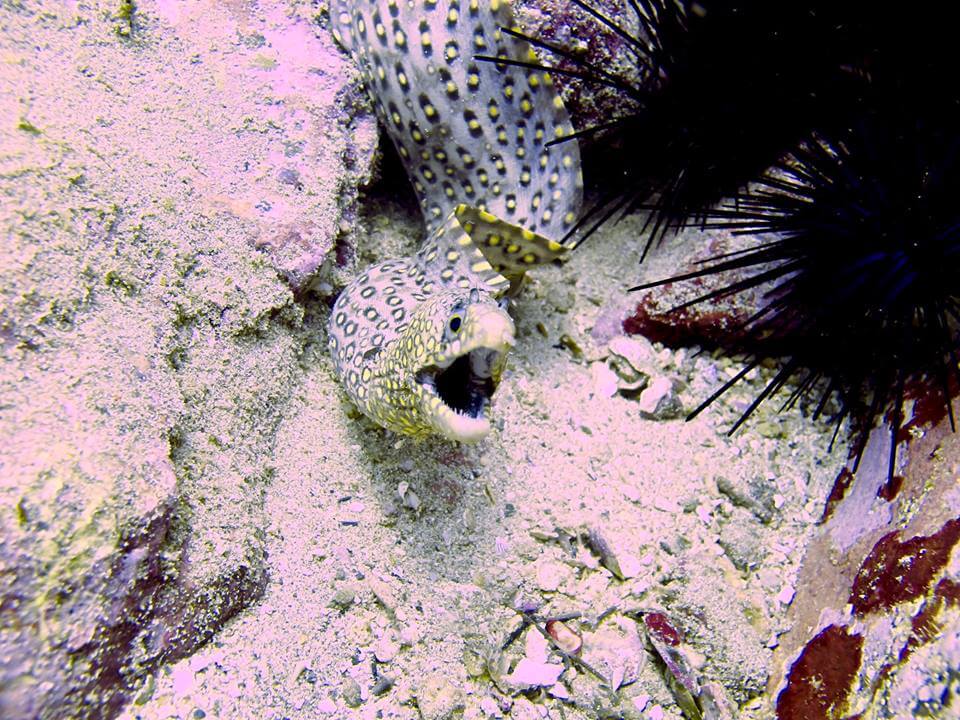Moray Eels
Hey there! It’s been a while but I am back with some new marine life to present you.
This time I would like to share my love for the moray eels. As a diver you probably already have seen many of these special animals and if you are like me, you are never sure if you can say that a moray eel is pretty. They look at you with their round eyes and big open mouth. They look angry all the time. Still, I believe them to be very unique and so much fun to observe. Here in the Zihuatanejo-Ixtapa region of Mexico we have different kind of moray eels and would like to show you the species I have encountered so far diving with Dive Zihua.
First, what is a moray eel?
The skin is scaleless and covered in mucus that can be toxic for some species. They are carnivorous preying on small fish, octopuses, squid, cuttlefish and crustaceans. Moray eels have a second set of jaws located way in the back of the mouth called pharyngeal jaws. They push it into the oral cavity to catch their food and carry it into the throat. Moray eels are apex predators with only few known fishes feeding on them like groupers, barracudas and sea snakes.
First, what is a moray eel?
Finding moray eels when we scuba dive here with Dive Zihua is a very fun game of hide and seek. The question is are you a good moray spotter!
Jewel moray eel – Muraena lentiginosa – Morena Pinta
The jewel moray eel is considered a small specie with a maximum length of 61 cm/2 ft and can be find at depths up to 27 m/90 ft. The body can be in various shades of light brown with white spots for adults and yellowish spots for juveniles. They possess a large pair of tubular nostrils above the mouth.
Zebra Moray eel – Gymnomuraena zebra – Morena Cebra
What a cutie this one! I have a little soft spot for their appearance I must say. The body is dark brown and white striped like a zebra, where their name comes from and can be as long as 60 cm/2 ft. The nose is short. They like coastal shallow water and coral reefs and won’t go deeper than 40 m/130 ft. Cool fact, they can release up to 10 000 eggs during reproduction.
Panamic Moray eel – Gymnothorax castaneus –Morena Verde Panámica
This is a big specie of moray that can reach 1.5 m/5 ft long. The body is large compared to the two previous species I just mentioned. The colour can vary but is mostly dark green with a brown head and forebody with occasional fine white yellow spots. They are also known as chestnut moray eel. This type of moray is common here is Zihuatanejo-Ixtapa and it is quite enjoyable to see because of its size. During our dives, they are normally good with the presence of divers. Funny thing is, just the other day, I saw two of them fight for a same hole between rocks. One of them won and saw the other retreat to find another place to stay. Better luck next time!
Finespotted Moray eel – Gymnothorax dovii – Morena Pintita
This moray looks a lot like the panamic moray. It is actually difficult when we dive to tell what specie we saw. The fine spotted moray is not very common and I had the chance to see it only a few times. The body is dark olive green to black with white fine spots covering much of the body. They can grow as long as 1.5 m/5 ft and can be found in shallow or deep waters up to 36 m/120 f. During our dives, they tend to be good with the presence of divers if you have the chance to meet one!
Argus Moray – Muraena argus – Morena Argos
When the water gets colder in Zihuatanejo-Ixtapa around april, the Argus moray eel shows up. It prefers to live in the deep between 18 m/60 ft to 60 m/200 ft but I have seen them in shallower sites in the Zihuatanejo bay. Their golden eyes with a black pupil gives them a little meaner look than others. The body is different shades of brown with a darker back and distinctive white blotches. They have a set of tubular nostrils above the mouth.
An observation I made during our dives, is that even if morays eels tend to only show their heads or forebodies out of their hiding spots, I have only witness the Argus moray completely out in the open. They were observing us, the scuba divers, very closely giving us a very big open mouth warning if we got to close. When the water gets warm in the summer, they probably retreat to colder deeper regions and hopefully will come see us again next spring.
Starry Moray – Echidna nebulosa – Morena Estrellada
The starry moray eel or snowflake moray actually looks like a beautiful small snake. The body is white with reticulated black pattern with two rows of brown-black bars with gold spots that doesn’t meet in the middle of the body. They reach up to 60 cm/2 ft and go as deep as 30 m/100 ft. The head is small with a short nose. This is a very pretty specie of moray. During our dives, they normally do not let scuba divers get very close and will disappear in a second if you invade their space. Be quick to spot them or you might miss your chance!
There you go ocean lovers, here are the 6 species of moray eels I have encountered so far scuba diving in Zihuatanejo. They will be here waiting for you to come join us for a fun day of diving!
Let’s go dive!
Maude Jetté
Scuba diving instructor/owner at Dive Zihua and marine biologist















